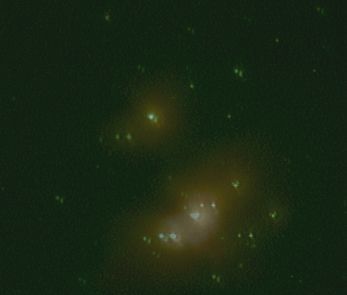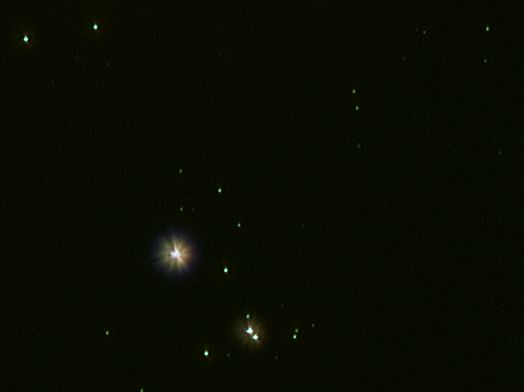M42 and M43, and Nair Al Saif 30th November 2004
 |
This is my first attempt at M42 using my 270mm SLR lens.
The lens was attached to my modified Toucam 840K and piggybacked on my ETX125.
This is not the most stable of platforms and not well aligned to the pole. Also the
piggyback is really a bit too heavy for this mount and obstructed the normal viewing port.
All these restrictions made for difficulties, so I am quite please to have got a result.
The picture is a combination of exposures of 2, 4, 8, 16, and 30 seconds with the lens fully open at f/7.
For details of the modifications to my Toucam 840K see here.
|
| Date and Time |
30th November 2004 between 23:51 and 00:28 UT |
Camera |
SC1-modified Toucam 840K |
Telescope |
135 mm, f/3.5 SLR lens with X2 teleadaptor. |
Capture |
K3CCDTools. High gamma, high saturation, 52% gain,
exposures 2, 4, 8, 16, 30 sec |
Processing |
K3CCDTools. ~20 frames stacked for each AVI.
Five resulting images aligned and stacked. Brightness -15, Gamma 1.5
PhotoImpact. Unsharp mask radius 3 factor 25. |
Nair Al Saif 30th November 2004
Move your mouse over the picture to see the HD designations and (magnitudes) of a few of the brighter stars.

|
These AVIs were taken by mistake but they have made a pretty picture anyway.
Nair al Saif (Arabic for "the bright one in the sword") is the brightest star in the picture at magnitude 2.8 and is the central star in a nebula
known as NGC1980, which extends much further than appears here. The mouseover shows the designations
of some of the stars in the HD catalogue and, in parentheses, their visual magnitudes.
Nair al Saif (Iota Orionis) itself is an interesting multiple-star system. The major star is a giant with a mass of
about 15 times that of the Sun and has a luminosity of at least 12,600 times that of the Sun from a surface at
31,500 K (compared to a mere 6,000 K for the Sun). The star is a spectroscopic binary, the companion orbiting in only 29 days,
and also has two other companions orbiting at at least 4,400 and 20,000 astronomical units in 75,000 and 700,000 years.
|
| Date and Time |
30th November 2004 between 23:16 and 23:40 UT |
Camera |
SC1-modified Toucam 840K |
Telescope |
135 mm, f/3.5 SLR lens with X2 teleadaptor. |
Capture |
K3CCDTools. High gamma, high saturation, 52% gain,
exposures 1.5, 5, 10, 15 sec |
Processing |
K3CCDTools. ~20 frames stacked for each AVI.
Four resulting images aligned and stacked.
PhotoImpact. Unsharp mask radius 2 factor 50. |
Home Back to DSOs



